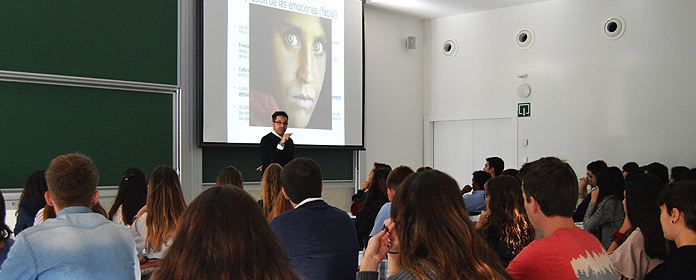17_9_20_EDU_students
2nd year Psychology students begin the Psychology of Motivation and Emotion internship.
These practices, which are being offered for the first time, include strategies such as role-playing and neuromarketing.

The second year students of the Degree in Psychology have started the practices of the subject "Psychology of motivation and emotion". This subject, taught by Dr. Elkin Luis, has as goal that Psychology students become able to identify and interpret the non-verbal language of patients and modulate their own emotional response to them. To achieve this goal, Professor Luis has designed four strategies that help students to identify, analyze and solve different problems related to the emotional and motivational level. This is the first year that these practices are being taught.
In the strategies proposed, the action units (such as raising an eyebrow) and the microexpressions studied by psychologist Paul Ekman are discussed. Paul Ekman in his work to determine the emotional state of another person. Emotions can be known through the face, postures and, additionally, the tone of voice.
The first strategy encompasses the so-called "feedback of the student's own emotion" and consists of applying techniques used by the neuromarketing. During the sessions, each student is asked to view an advertising spot on the computer while a camera records his or her reactions. A computer program measures the valence of the emotions and places student within the population range they have analyzed.
The second dynamic, "group analysis of emotional behavior", proposes that the students, divided into groups of five, record the reactions of one of them together with those of another person who interacts with him/her, who may be an acquaintance of student or not related to him/her at all. The videos are then displayed on class and the students should analyze the different action units, determine which is the most important and say which emotions were being exposed. In parallel, the same video would have been sent to the business Affectiva (which is professionally dedicated to the analysis of this field) with which the results are compared. In order to be able to analyze emotions correctly, the students had to study a guide in which the action units are described.
"Training with standardized patients," the third strategy, will take place at the simulation center in October. The aim is to train in role playinga technique through which a group simulates a status that occurs in real life. The students will face actors who will pretend to be patients, to whom the clinical picture has been previously sent and whose performance has been previously seen by those responsible for the subject . The goal of this dynamic is to imagine the way of acting and the decision that each of the participants would take in the different situations.
The last strategy is "role playing training" and will take place in November at the simulation center. During a workshop two guest teachers will come to the simulation center to observe what the students have learned in the previous strategies and to see if they have managed to train themselves to distinguish emotions.

